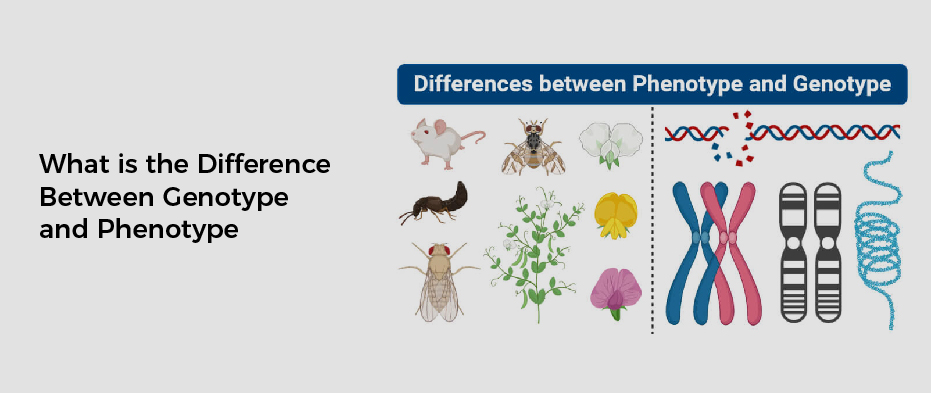When discussing the difference between the genotype and phenotype, we’re referring to a genetic variation in a person’s DNA.This variation can be either homozygous or heterozygous. The exact difference is important because it can affect your health and well-being.For example, a homozygous genotype of a certain gene may increase your risk of developing certain diseases or conditions.
On the other hand, if you have a heterozygous genotype in this same gene, it may not impact your health at all. Understanding these differences and how they relate to an individual’s phenotype is crucial for researchers, clinicians, and others working in genetic research.
What is Genotype & Phenotype?
Genotype and phenotype are two terms that are important in the field of genetics. Genotype refers to the genetic makeup or alleles present in an individual, while phenotype refers to the observable traits or characteristics exhibited by that individual.
Generally, the genotype is determined by a combination of genes that an individual inherits from their parents, while genetic and environmental factors influence phenotype. For example, two individuals may have the same genotype but different phenotypes or different genotypes but similar phenotypes.
How Do You Identify a Genotype?
There are many methods that can be used to determine genotypes, including genetic testing and DNA sequencing. Genetic testing involves analyzing specific genes or segments of DNA to identify any abnormalities or mutations that may be present. DNA sequencing uses automated technologies to generate a detailed map of an individual’s entire genome, which can provide information about their genotype.
To identify a genotype, it is also important to consider an individual’s family history and other factors that may have influenced their genetic makeup. This can help to provide a complete picture of the factors involved in determining genotype and phenotype.
Although there are many similarities between genotype and phenotype, these two concepts are important to understand if you are working in the field of genetics.
Difference Between Genotype & Phenotype
Homozygous vs. heterozygous is a term used in biology to describe organisms with different alleles at the gene locus phenotypes. Both types of alleles, dominant and recessive alleles, are inherited from both parents during sexual reproduction. A dominant allele is expressed to produce a phenotype, and a recessive allele is silent.
In humans, the X and Y chromosomes are the two sex chromosomes. When these chromosomes pair up, a gamete is formed. The chromosomes carry genes in a linear order. However, these patterns of inheritance are not the same for men and women.
All living organisms have two sets of chromosomes. When paired up during fertilization, these chromosomes ensure that the offspring have phenotypic differences from their parents. Humans have 23 pairs of chromosomes. Most animals and plants have two sets of chromosomes.
Variable Expressivity
Variable expressivity is the difference between the phenotypic expression of a genetic variant and its normal counterpart. This can be attributed to various factors, including genetics, lifestyle, and environmental influences. One common example of variable expressivity is polydactyly. It can be caused by a single mutation or a family history of polydactyly.
However, there is a lot of information available regarding the subject. For instance, a growing body of evidence explains the molecular mechanism underlying variable phenotypes. These findings will prove useful to clinicians seeking to understand and predict complex disorders’ manifestations.
There is also a fair amount of misinformation in the scientific community about variable expressivity. Although it is not well understood, it is a common finding in autosomal dominant conditions. Some studies indicate that a combination of genetic, environmental, and lifestyle factors may explain the variations in phenotypes.
How Are Alleles Different from Genotypes?
Alleles are one aspect of an individual’s genotype, and they describe the specific forms or variations of a gene that an individual has. Alleles can be either dominant or recessive.It can depend on their impact on the observable traits or characteristics that make up a person’s phenotype. Because alleles influence how our genes are expressed, they are important in determining our genotype and phenotype.
Understanding alleles, genotypes, and phenotypes can help researchers, clinicians, and others working in the field of genetics better understand how genetic variation impacts characteristics like disease risk, physical appearance, and more.
Final Words
Genotype and phenotype are two central concepts in genetics that are important for understanding how genetic variation impacts an individual’s traits and characteristics. Understanding these concepts can help researchers, healthcare professionals, and others working in the field better understand the complex relationship between genes, environment, and observable traits. Whether trying to identify a genotype or looking at how genetic variation affects phenotype, it is important to consider all of the factors involved in genotype and phenotype.


